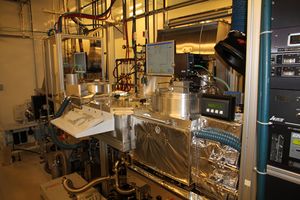Difference between revisions of "ICP-PECVD (Unaxis VLR)"
m (→Recipes: format link to bold/underline) |
|||
| (3 intermediate revisions by 2 users not shown) | |||
| Line 27: | Line 27: | ||
*Multiple 4” diameter wafer capable system |
*Multiple 4” diameter wafer capable system |
||
*Pieces possible by mounting or placing on 4 ” wafer |
*Pieces possible by mounting or placing on 4 ” wafer |
||
| + | |||
| + | The system currently has '''Deuterated Silane (SiD<sub>4</sub>)''' installed - identical to the normal Silicon precursor SiH<sub>4</sub>, except that it significantly lowers optical absorption in the near-infrared. This gas is '''expensive''' and thus more applicable to optical application than to general-purpose SiN films. |
||
=Documentation= |
=Documentation= |
||
| − | *Operating Instructions |
+ | *[[Unaxis VLR ICP-PECVD - Std. Operating Procedure|Operating Instructions]] |
| − | *[[Unaxis wafer coating procedure]] |
+ | *[[Unaxis wafer coating procedure]] - ''process flow for achieving high-quality coatings.'' |
| − | *For particle counting |
+ | **For particle counting procedure, see the [https://wiki.nanotech.ucsb.edu/wiki/Wafer_scanning_process_traveler Surfscan Scanning Procedure] |
| + | |||
| + | *Online Training Video: |
||
| + | **[https://gauchocast.hosted.panopto.com/Panopto/Pages/Viewer.aspx?id=1af6f3ce-8fc4-4a50-884a-ae3600d2863d <u>Unaxis ICP-PECVD Training</u>] |
||
| + | **'''Important:''' ''This video is for reference only, and does not give you authorization to use the tool. You must be officially authorized by the supervisor before using this machine.'' |
||
| + | |||
| + | You must log in using your UCSB ID Net account information BEFORE viewing the video or you will have to watch the video again. |
||
| − | == |
+ | ==Recipes== |
| − | You can find recipes for this tool on the Wiki > Recipes > [https://wiki.nanotech.ucsb.edu/wiki/PECVD_Recipes#ICP-PECVD_.28Unaxis_VLR.29 PECVD Recipes page] |
+ | You can find recipes for this tool on the Wiki > Recipes > [https://wiki.nanotech.ucsb.edu/wiki/PECVD_Recipes#ICP-PECVD_.28Unaxis_VLR.29 '''<u>PECVD Recipes page</u>'''] |
Revision as of 13:30, 29 March 2022
| |||||||||||||||||||||
About
This system is configured as an ICP PECVD deposition tool with 1000 W ICP power, 600 W RF substrate power, and 100°C-350°C operation. This chamber has 100% SiD4, N2, O2, and Ar for gas sources. The high density PECVD produces a more dense, higher quality SiO2 and Si3N4, as compared with conventional PECVD. With the high density plasma, deposition of high quality films can be deposited as low as 100°C for processes requiring lower temperatures. Stress compensation for silicon nitride is characterized.
Cluster Configuration
A Deposition and Etch chamber are both attached to the same loadlock, allowing etching and deposition without breaking vacuum. Each chamber can be scheduled separately on SignupMonkey.
- PM3: ICP-PECVD Deposition (this page)
- PM1: ICP Etch (Unaxis VLR)
Detailed Specifications
- 1000W ICP source, 600W RF Sample Bias Power Supply
- 100 - 350°C sample temperature
- 100% SiD4, Ar, N2, O2
- Multiple 4” diameter wafer capable system
- Pieces possible by mounting or placing on 4 ” wafer
The system currently has Deuterated Silane (SiD4) installed - identical to the normal Silicon precursor SiH4, except that it significantly lowers optical absorption in the near-infrared. This gas is expensive and thus more applicable to optical application than to general-purpose SiN films.
Documentation
- Operating Instructions
- Unaxis wafer coating procedure - process flow for achieving high-quality coatings.
- For particle counting procedure, see the Surfscan Scanning Procedure
- Online Training Video:
- Unaxis ICP-PECVD Training
- Important: This video is for reference only, and does not give you authorization to use the tool. You must be officially authorized by the supervisor before using this machine.
You must log in using your UCSB ID Net account information BEFORE viewing the video or you will have to watch the video again.
Recipes
You can find recipes for this tool on the Wiki > Recipes > PECVD Recipes page
